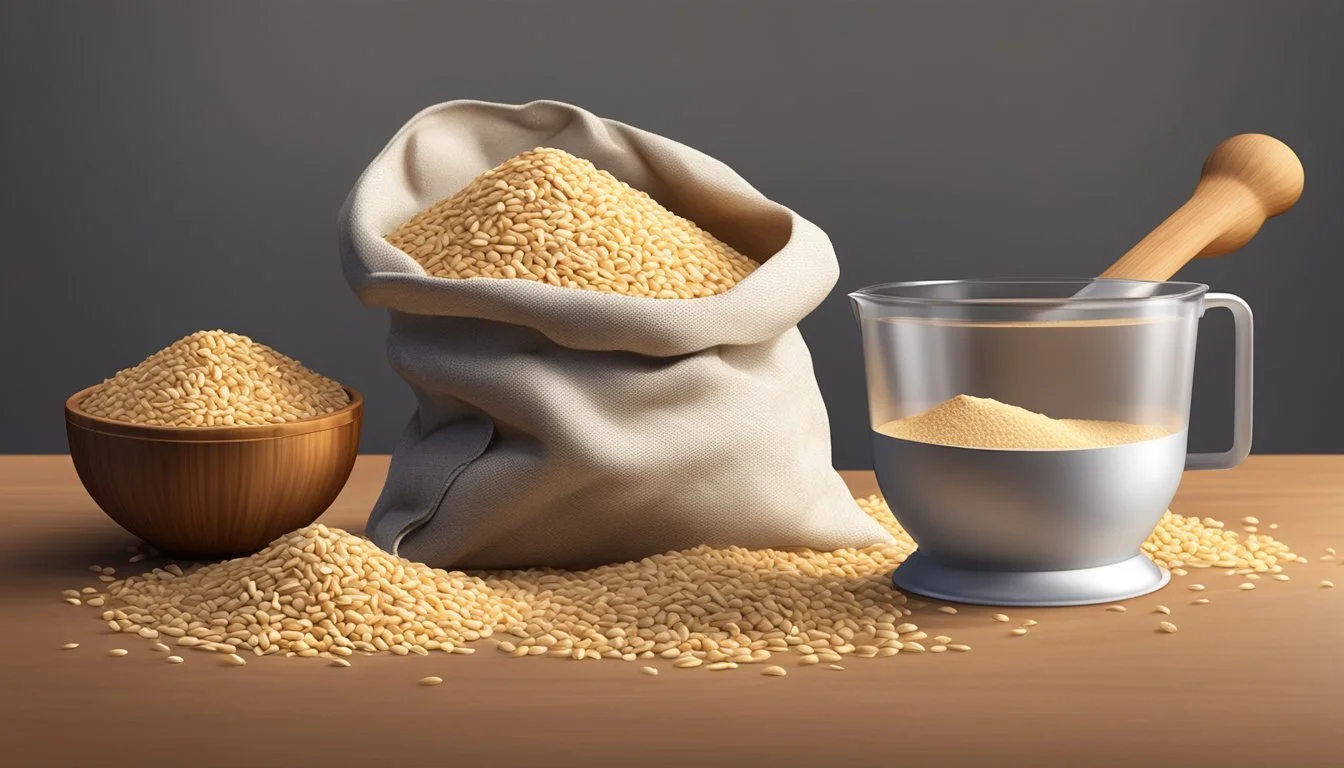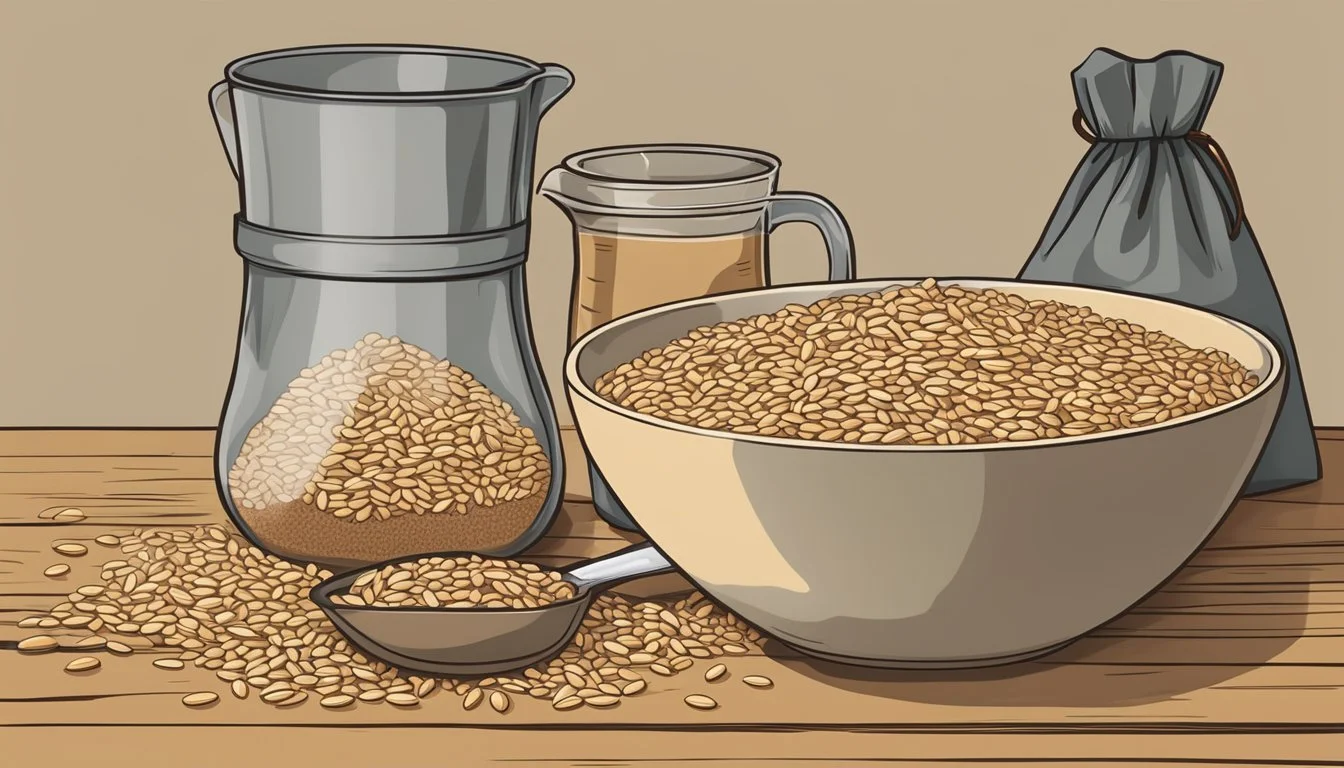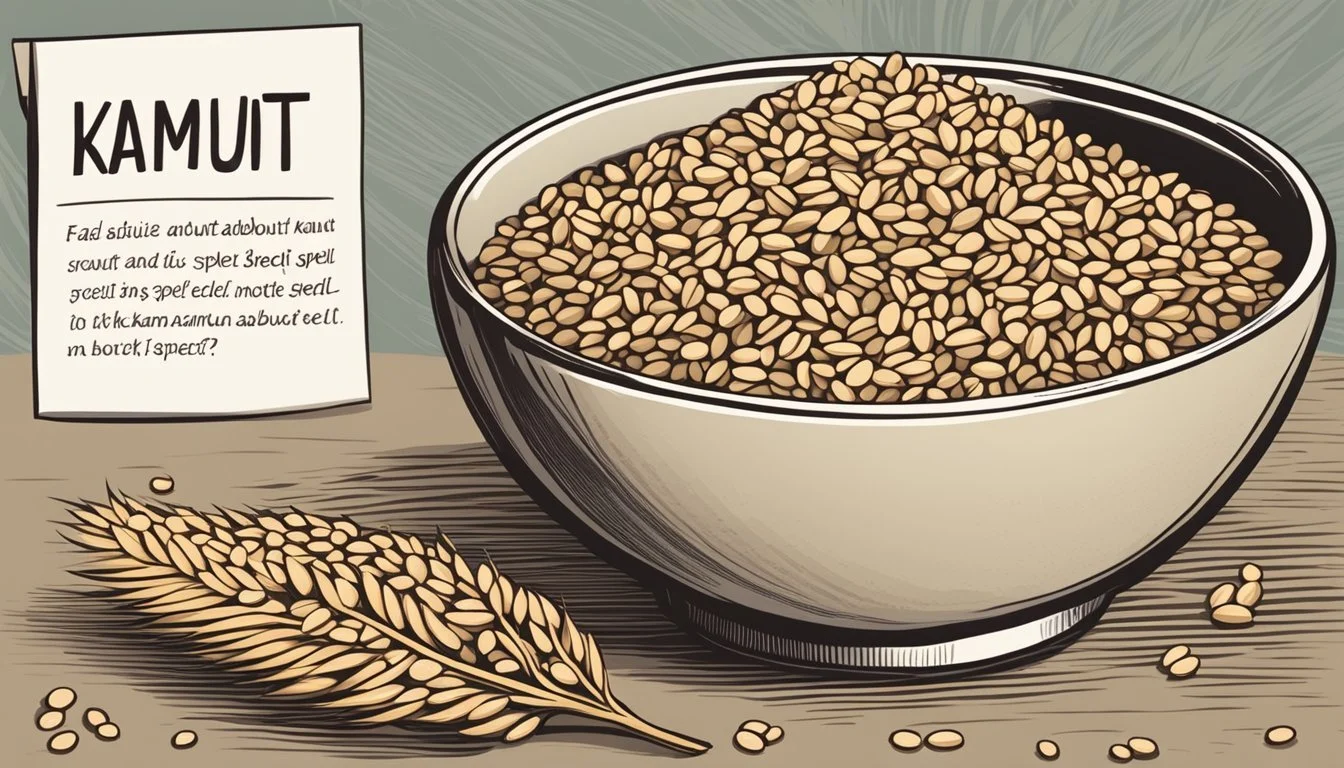How to Substitute Kamut for Spelt
A Simple Guide for Bakers
Substituting Kamut for spelt in recipes offers an opportunity for bakers and chefs to introduce variety in texture and nutrition without compromising on flavor. Kamut, an ancient grain similar to wheat, boasts a rich, buttery taste and is known for its higher protein and fiber content compared to spelt, which also provides a nutty flavor and a range of nutrients. When incorporating Kamut into dishes that typically use spelt, it's important to understand the unique qualities of both grains to achieve the best results.
Kamut's slightly higher protein content, compared to spelt, makes it particularly beneficial for muscle repair, while its fiber aids in digestive health, making it a nutritious option for breads, pastas, and other baked goods. The grain's versality means it can be easily ground into flour and used in a 1:1 ratio as a substitute for spelt flour, accommodating those who wish to adjust their recipes for nutritional reasons or simply for a different culinary experience.
The nuances in the flavor profile of these grains are subtle, yet noticeable in the finished product. Spelt tends to impart a milder taste, making it suitable for dishes where a more pronounced grain flavor is preferred. When replacing spelt with Kamut, chefs may expect a slightly sweeter and more buttery flavor, enhancing soups, stews, and salads, along with offering a satisfying texture in baked goods. This straightforward substitution process empowers individuals to diversify their diet and explore ancient grains with confidence.
Understanding Kamut and Spelt
Kamut and spelt are both ancient grains with deep historical roots and unique nutritional profiles. They offer different culinary characteristics and health implications while impacting the environment distinctly.
Historical Background of Kamut and Spelt
Kamut, also known as Khorasan wheat (Triticum turgidum ssp. turanicum), is believed to have originated in the Fertile Crescent, with claims of its discovery ranging from Egypt to Iran. Spelt (Triticum spelta), in contrast, has been a staple in parts of Europe for centuries, evidencing a long history of cultivation.
Nutritional Comparison of Kamut and Spelt
Protein: Kamut typically provides a higher protein content of about 7 grams per 100 gram serving, compared to spelt's 5.5 grams.
Fiber: Kamut also has a more robust fiber profile, offering around 7 grams compared to spelt's 4 grams per serving.
Vitamins and Minerals: Both grains include vitamins B, minerals such as magnesium, phosphorus, iron, and selenium, but the specific quantities can vary between the two.
Culinary Characteristics
Kamut imparts a nutty and buttery flavor, with a texture that remains firm when cooked. It enhances dishes that benefit from its distinct flavors. Spelt has a milder taste profile and can add a slight chewiness to foods, suitable for a variety of recipes including soups, salads, and baked goods.
Availability and Varieties
Both spelt and Kamut are available in several forms such as whole grain, flour, and flakes. Other ancient grains in the same category include einkorn, amaranth, farro, and quinoa. These can often be found in health food stores or sections specializing in organic and whole foods.
Health Considerations
Kamut and spelt contain gluten, so they are not suitable for those with celiac disease or gluten sensitivities. However, for others, they provide significant nutritional benefits owing to their high levels of dietary fiber, antioxidants, and potential to aid in preventing chronic diseases such as type 2 diabetes.
Environmental Impact
The cultivation of Kamut and spelt tends to be more environmentally friendly than modern wheat as they generally require fewer chemical inputs. They are often grown organically, which can reduce the environmental impact associated with pesticide and fertilizer use.
Substituting Kamut for Spelt
When substituting kamut for spelt, it's important to consider the differences in protein, fiber, gluten content, texture, and hydration requirements, as these can affect the final product in your baking recipes.
Basic Substitution Ratios
For those looking to replace spelt with kamut in a recipe, start with a 1:1 substitution ratio. Kamut can directly replace spelt flour in many recipes including bread, cakes, muffins, and pastries. However, slight adjustments might be necessary depending on the specific recipe.
Adapting Recipes for Texture and Taste
Kamut imparts a richer, buttery flavor compared to the nutty taste of spelt. It also has a higher protein content, which may give baked goods a denser structure. To match the lighter texture of spelt, bakers might consider combining kamut flour with all-purpose or whole wheat flour.
Adjusting Liquid Content in Baking
Due to its higher protein and fiber content, kamut flour might require more liquid than spelt flour to achieve a comparable dough consistency. Increase hydration slightly when using kamut in place of spelt to maintain a similar batter or dough texture in recipes like bread or pasta.
Gluten Content and Structure Considerations
While both spelt and kamut contain gluten, kamut flour creates a stronger gluten network due to its higher protein content. This is crucial for bread recipes where gluten structure is important. For a less chewy texture as you would get with spelt, consider kneading the dough less when using kamut flour.
Other Factors to Consider
Keep in mind that the bake time may vary when substituting kamut for spelt as it might brown more quickly due to its higher protein content. Additionally, because kamut kernels are larger than spelt, using them whole in recipes will result in different textures and cooking times.
Alternative Substitutes to Spelt and Their Uses
When seeking a substitute for spelt in recipes, it is essential to consider the specific dietary needs and desired nutritional values. Here are some tailored alternatives categorized by their unique attributes.
Gluten-Free Alternatives
For those with gluten sensitivity or celiac disease, finding a gluten-free option that mimics spelt's properties is a priority.
Rice Flour: Offers a neutral flavor and is widely used in gluten-free baking.
Buckwheat: Despite the name, it's gluten-free and provides a similar nutty taste to spelt.
Almond Flour: Rich in protein and flavor, ideal for a gluten-free diet.
Amaranth or Quinoa: Ancient grains that are gluten-free and add a high protein content to dishes.
Whole Grain and High Protein Options
To maintain the high protein content and fiber that spelt provides, consider these whole grain substitutes.
Kamut: An ancient grain offering high protein and a rich, buttery flavor.
Quinoa: A complete protein source that's also high in fiber.
Whole Wheat Flour: Contains a significant amount of protein and fiber, though it's not gluten-free.
Budget-Friendly and Accessible Substitutes
Cost and availability are practical considerations, and certain substitutes offer convenience without compromising on quality.
All-Purpose Flour: Easily found and affordable, though it may alter the nutritional profile.
Whole Wheat Flour: More accessible than spelt and can be used in a 1:1 ratio in most recipes.
Special Dietary Consideration Substitutes
When dietary restrictions extend beyond gluten intolerance, such as for vegan or vegetarian diets, there are still plenty of alternatives.
Almond Flour: A good fit for both gluten-free and high-protein diets, suitable for vegetarians and vegans.
Buckwheat: Also caters to those on vegan or vegetarian diets, offering both gluten-free and high fiber benefits.
Amaranth or Quinoa: These are not only gluten-free but also provide essential amino acids making them ideal for strict dietary requirements.
Kamut in the Kitchen
Incorporating Kamut into the kitchen unveils its nutty taste and versatility across various dishes, from hearty stews to delicate pastries. Appreciated for both its flavor and texture, Kamut is a valuable grain for anyone looking to diversify their culinary repertoire.
Baking with Kamut
Kamut flour is a fantastic choice for baking due to its rich, buttery taste. It works particularly well in breads, muffins, and other baked goods. When substituting Kamut for spelt:
Breads: Increase hydration slightly, as Kamut absorbs more liquid.
Cakes and Pastries: Mix Kamut with other flours for lighter textures.
For cookies, expect a crisper texture with a delightful complexity.
Savory Dishes and Alternatives
Kamut's slightly sweet and nutty flavor enriches savory recipes such as pasta, pilafs, stews, and salads. When used in place of spelt:
Pasta: Kamut holds its shape well, offering a chewy bite.
Salads: Use cooked Kamut grains to add substance and a pleasant chew.
Kamut's versatility shines in both vegetarian and vegan dishes.
Cooking Techniques and Tips
To fully harness Kamut's culinary potential:
Soak grains overnight to shorten cooking times.
Cook Kamut grains in a ratio of 1:3 (Kamut to water) until tender.
Kamut flour can be denser than spelt flour; adjust recipes accordingly for desired textures.
Pairing Kamut with Other Ingredients
Kamut pairs brilliantly with various ingredients:
Vegetables: Root vegetables and leafy greens complement its earthy tones.
Proteins: Rich flavors like those of lamb or beef balance Kamut's nuttiness.
Incorporate Kamut into your dishes to enrich the overall flavor profile.
FAQs about Kamut and Spelt
This section provides a comprehensive overview of frequently asked questions regarding Kamut and Spelt, addressing concerns ranging from dietary implications to storage practices.
Common Concerns and Questions
Is Kamut gluten-free? No, Kamut contains gluten, making it unsuitable for individuals with celiac disease or gluten sensitivity. Spelt also contains gluten but is sometimes better tolerated by those with mild sensitivities, not celiac disease.
Can Kamut be used by people with wheat allergies? As Kamut is a type of wheat, those with wheat allergies should avoid it, as well as Spelt.
Nutritional content comparison:
Kamut: High in protein, fiber, vitamins, and minerals.
Spelt: Offers a good balance of protein and fiber.
Mineral content:
Both Kamut and Spelt are excellent sources of various minerals such as magnesium and zinc.
Storage and Shelf Life
Kamut and Spelt grains should be stored in airtight containers in a cool, dry place to maximize shelf life, which can be up to six months. Whole-grain flours, however, should be used within three months or stored in the freezer to extend freshness.
Cooked Kamut and Spelt should be refrigerated and consumed within a few days.
Finding and Purchasing
Kamut and Spelt can be found in most natural food stores, and in the organic or health sections of many grocery chains. Online shopping is another convenient option with an often wider variety.
When buying, consider bulk purchasing to reduce cost, but be mindful of the increased need for proper storage.
Tips for First-Time Users
Cooking: When substituting Kamut for Spelt, one might need to adjust the amount of liquid and cooking time due to Kamut's larger grain size and higher protein content.
Baking: Important baking tip for beginners—whole grain flours absorb more liquid than processed flours, therefore increasing moisture might be necessary to prevent a dry result.
These tips serve as a starting point for those new to cooking and baking with these ancient grains.
Conclusion
When substituting Kamut for spelt, individuals should focus on both the culinary and nutritional aspects of these ancient grains. Kamut is distinguished for its higher protein and fiber content, which contributes to muscle repair, digestive health, and overall wellness.
Kamut's Nutritional Edge:
Protein: Approximately 7 grams per 100 grams, beneficial for muscle repair.
Fiber: Roughly 7 grams per 100 grams, aiding digestive health.
In comparison, spelt provides a similar nutritional profile with about 5.5 grams of protein and 4 grams of fiber per 100 grams. Both grains contain essential minerals such as magnesium, zinc, and iron, key for various bodily functions including immune support and metabolism.
For those with gluten sensitivity, it is important to note that both Kamut and spelt contain gluten. However, some individuals who are sensitive to modern wheat might find these ancient grains more digestible.
In the kitchen, Kamut offers a nutty and slightly sweet flavor, enriching an array of dishes from bread to salads. It is usually an easy 1:1 substitute for spelt in recipes, although slight adjustments in liquid content may be required due to its different absorption rates.
Culinary Tips:
Flavor Profile: Nutty and sweet, enhances various recipes.
Adjustments: Monitor moisture in recipes and adjust as needed.
One should consider these factors to successfully incorporate Kamut into meals, maintaining not only the integrity of their dishes but also optimizing the health benefits of their dietary choices.
References
When substituting spelt for Kamut, one can refer to various sources that provide nutritional comparisons and substitution guidelines for these ancient grains. Relevant references have been structured as follows for conciseness and ease of understanding:
Nutritional Content: Analyses indicate that both grains are high in protein and fiber, which are important for muscle repair and digestive health. Kamut generally provides around 7 grams of protein and 7 grams of dietary fiber per 100 gram serving, slightly more than spelt.
Nutrient Kamut (per 100g) Spelt (per 100g) Protein ~7g ~5.5g Fiber ~7g ~4g
Health Benefits: Both grains are rich sources of essential minerals such as magnesium and zinc, which contribute to immune support and metabolic processes. Additionally, they are noted for containing iron, necessary for blood health, and selenium, an antioxidant.
Mineral Grain Magnesium Both Zinc Both Iron Both Selenium Kamut
Flavor Profile: Spelt adds a mild, slightly sweet, and nutty flavor to dishes, which is generally considered less pronounced than the bold taste of Kamut.
Culinary Uses: Both Kamut and spelt can be used in a variety of recipes including soups, stews, salads, and baked goods. Using spelt as a substitute will yield a different texture and flavor profile, but it can be a healthier alternative to conventional wheat in many recipes.
Please note that the ratios for substitution may vary based on the type of recipe and desired consistency. It's advisable to start with a one-to-one replacement and adjust as needed.







